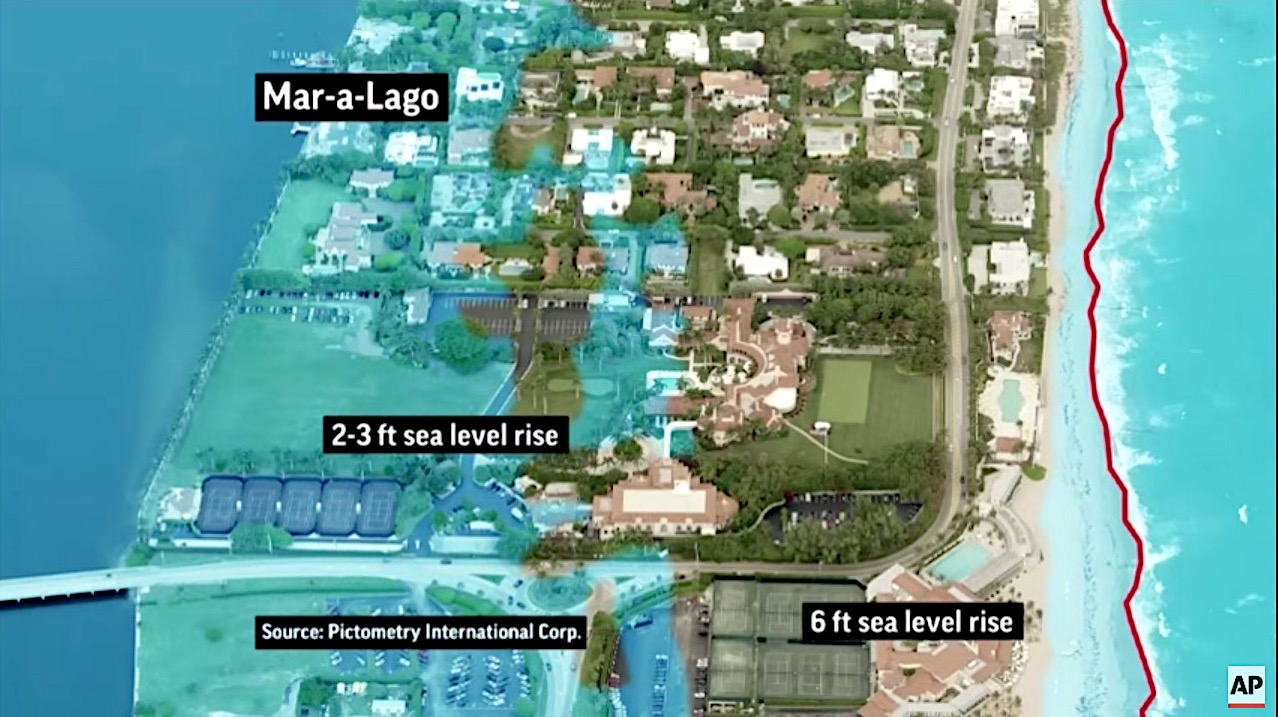Mar-a-Lago could be underwater by 2100, thanks to Trump pulling out of Paris accord


President Trump and his aides won't really say if Trump believes in climate change, following his decision to withdraw the U.S. from the Paris climate accord, but the melting polar ice caps probably don't care much what Trump thinks. "The president's Mar-a-Lago estate, the soaring apartment towers bearing his name on Miami-area beaches, and his Doral golf course are all threatened by rising seas, according to projections from the National Oceanic and Atmospheric Administration and the South Florida Regional Climate Change Compact," The Associated Press reports.
If sea levels rise 2 to 3 feet by 2100, as scientists believe they might, Mar-a-Lago's western lawns will be underwater, as will roads and bridges connecting Trump's private club, built on a Florida barrier island, to the mainland. Using a worst-case rise of 6 feet, more likely without U.S. meeting or exceeding its now-abandoned Paris emissions targets, Mar-a-Lago will be below sea level, along with more than half of the other $11 million-plus homes in Palm Beach.
Trump's "properties live off of tourism — golfing communities, places where fat cats go and spend money and hobnob," Coral Gables Mayor Jim Cason, a Republican, tells AP. "If the beaches are gone or the streets are flooded, it's going to affect the value of his property," he adds. "So as a prudent businessman, he ought to conclude that the science is right and we need to prepare and plan." Trump's resorts and golf courses in Hawaii, Ireland, Canada, Panama, Uruguay, and Mumbai, India, are also vulnerable to rising sea levels. You can learn more about the threats to Trump's Florida properties in this report from AP's Alex Sanz. Peter Weber
The Week
Escape your echo chamber. Get the facts behind the news, plus analysis from multiple perspectives.

Sign up for The Week's Free Newsletters
From our morning news briefing to a weekly Good News Newsletter, get the best of The Week delivered directly to your inbox.
From our morning news briefing to a weekly Good News Newsletter, get the best of The Week delivered directly to your inbox.
A free daily email with the biggest news stories of the day – and the best features from TheWeek.com
Peter has worked as a news and culture writer and editor at The Week since the site's launch in 2008. He covers politics, world affairs, religion and cultural currents. His journalism career began as a copy editor at a financial newswire and has included editorial positions at The New York Times Magazine, Facts on File, and Oregon State University.
-
 TikTok secures deal to remain in US
TikTok secures deal to remain in USSpeed Read ByteDance will form a US version of the popular video-sharing platform
-
 Unemployment rate ticks up amid fall job losses
Unemployment rate ticks up amid fall job lossesSpeed Read Data released by the Commerce Department indicates ‘one of the weakest American labor markets in years’
-
 US mints final penny after 232-year run
US mints final penny after 232-year runSpeed Read Production of the one-cent coin has ended
-
 Warner Bros. explores sale amid Paramount bids
Warner Bros. explores sale amid Paramount bidsSpeed Read The media giant, home to HBO and DC Studios, has received interest from multiple buying parties
-
 Gold tops $4K per ounce, signaling financial unease
Gold tops $4K per ounce, signaling financial uneaseSpeed Read Investors are worried about President Donald Trump’s trade war
-
 Electronic Arts to go private in record $55B deal
Electronic Arts to go private in record $55B dealspeed read The video game giant is behind ‘The Sims’ and ‘Madden NFL’
-
 New York court tosses Trump's $500M fraud fine
New York court tosses Trump's $500M fraud fineSpeed Read A divided appeals court threw out a hefty penalty against President Trump for fraudulently inflating his wealth
-
 Trump said to seek government stake in Intel
Trump said to seek government stake in IntelSpeed Read The president and Intel CEO Lip-Bu Tan reportedly discussed the proposal at a recent meeting


